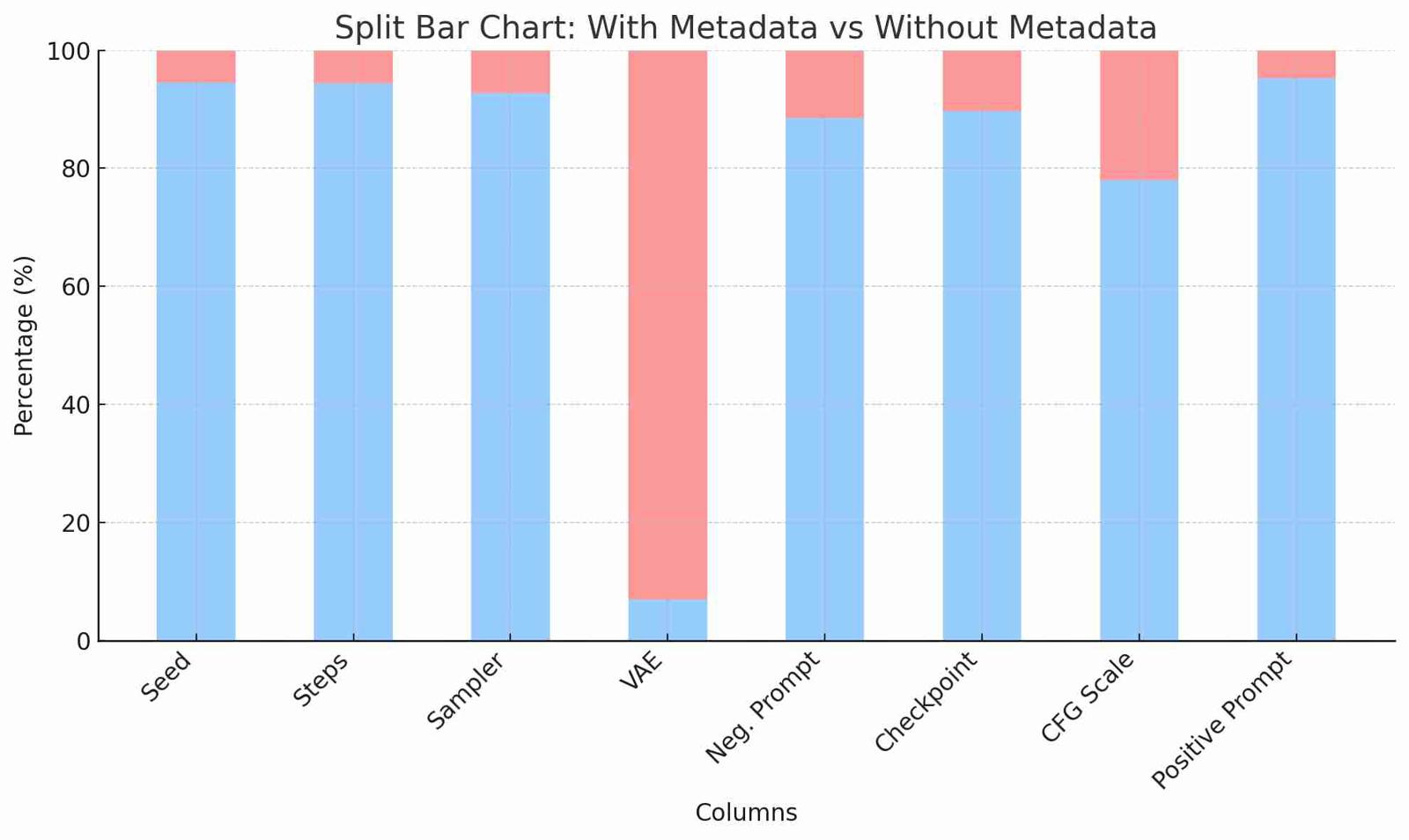After analyzing 750K records from CivitAI, I set out to understand key patterns in metadata usage by the community. The data reveals intriguing trends in how users configure their image generation parameters—ranging from prompt lengths to CFG scales and samplers. This analysis provides a statistical overview of the data, allowing for deeper insights into how the CivitAI community utilizes metadata in their creations. While I won't be offering direct guidance on improving image quality, I'll share my interpretations and opinions on what these results might mean for the platform and its users.
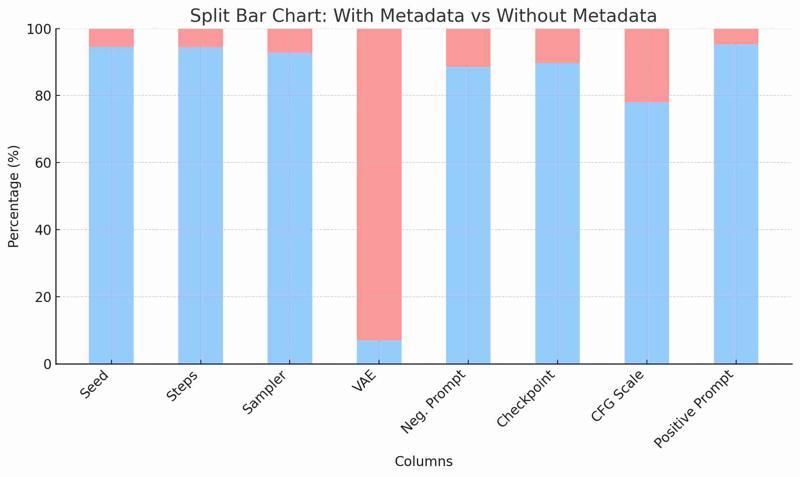
Chart 1: Metadata Capture Rates
The chart above represents the percentage of key generation parameters that were successfully captured from the 750K records analyzed on CivitAI. The parameters include Seed, Steps, Sampler, VAE, Negative Prompt, Checkpoint, CFG Scale, and Positive Prompt.
Key Insights:
1. 90% Metadata Captured (Excluding VAE): Across most parameters, I was able to capture around 90% of the data. This is a significant achievement considering the large dataset.
2. VAE Misrepresentation: One major outlier is the VAE parameter. The chart shows a low capture rate for VAE, but this is partly due to a lack of distinction between "default/not set" and "not parsed." As a result, it appears underrepresented in the dataset.
3. 750K Sample Size: This data represents the results of analyzing a total of 750K records. The chart visualizes how much key metadata was successfully parsed from the sample. Only records that were saved and parsed are ones with the tag with "flat chest", "small breasts" and "petite".
4. CFG Scale – The Most Difficult Parameter: The CFG Scale parameter was the most challenging to extract, with a capture rate below 80%. It appears this parameter requires further attention in future data improvements.
5. Upcoming In-Depth Analysis: In the subsequent parts of this article, I will dive deeper into the analysis of individual fields, providing a more detailed look into prompt lengths, samplers, and CFG scales.

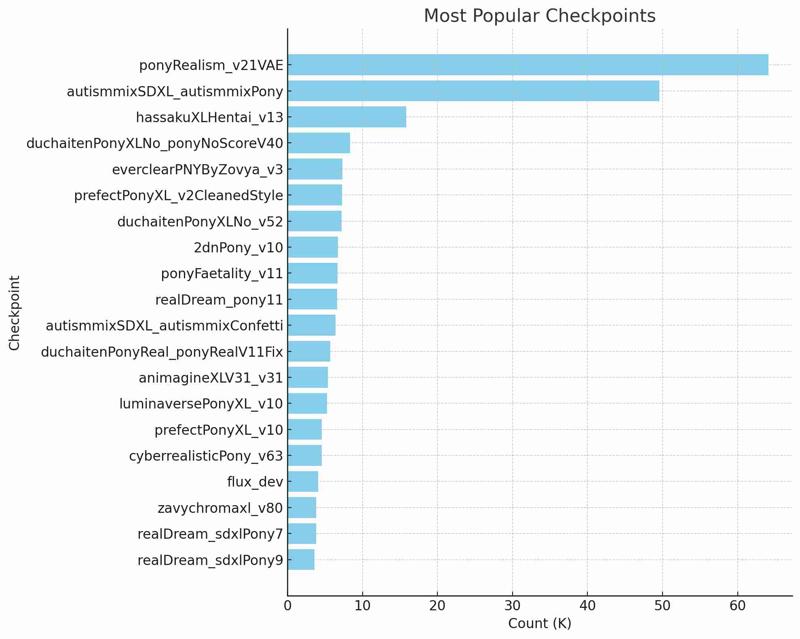
Here's a detailed analysis of the two groups (realistic vs. unrealistic models) based on the data:
Unrealistic Models:
- Top Models: Models like autismmixSDXL_autismmixPony, hassakuXLHentai, duchaitenPonyXL, and 2dnPony demonstrate strong popularity within the community. The focus of these models often leans toward more artistic or stylized results, designed for fantasy or non-realistic outputs.
- AutismmixSDXL_autismmixPony stands out as one of the most prominent unrealistic models with 49,547 uses. This emphasizes the community's preference for creative, stylized, and non-realistic art, especially in the context of pony or anime-themed generations.
- Other models like hassakuXLHentai_v13 and duchaitenPonyXLNo_ponyNoScoreV40 indicate a steady trend towards niche generation styles, with uses ranging from 15,851 to 8,348, signaling that niche aesthetics maintain a strong hold within the community.
- The pony theme clearly dominates the unrealistic model spectrum, as highlighted by names like ponyFaetality_v11 and 2dnPony_v10. These models showcase the specialized nature of the community's preference for pony-based or cartoonish generations.
Realistic Models:
- PonyRealism_v21VAE leads the way with 64,089 uses, reflecting a strong community interest in more realistic outputs. Models with "real" in their names, such as duchaitenPonyReal_ponyRealV11Fix and realDream_pony11, also support this trend, although they operate on a smaller scale (e.g., 5,722 and 6,648 uses respectively).
- EverclearPNYByZovya_v3 is another notable model in the realistic spectrum, garnering 7,334 uses, showing that realism-based pony models, while not as prominent as the fantasy variants, still have a dedicated user base.
- Realistic models seem to provide a more grounded and photorealistic style, catering to users seeking high-quality, lifelike outputs rather than stylized or exaggerated ones.
Mixed Themes and Notable Mentions:
- Flux_dev: Interestingly, this is the only non-pony-based model in the top 20, boasting 4,066 uses. Its inclusion highlights the presence and rising prominence of models focused on broader AI-generated art within the CivitAI community. Its growing popularity shows that while pony and anime-based models dominate, the demand for more diverse content is increasing.
- The realDream_sdxlPony series: With varying versions like sdxlPony7 and sdxlPony9, the realDream models strike a balance between realism and stylized generation, making them appealing to users seeking a hybrid of realistic and creative outputs.
Popularity Breakdown
- Realistic Models (including "real", "everclear", "flux", and "cyberrealistic"):
- Total Count: 99,825
- Percentage: 44%
- Unrealistic Models (everything else):
- Total Count: 127,045
- Percentage: 56%
This shows that 44% of the models fall into the realistic category, while 56% are classified as unrealistic.
Final Thoughts:
The CivitAI community is heavily influenced by pony-based models, with a clear split between those seeking realistic outputs and those leaning toward highly stylized or fantasy-based generations. The success of models like PonyRealism and Autismmix highlights the diversity in artistic preferences, while the rising use of non-pony models like Flux_dev signals the expanding interests within the community. Over time, we can expect a broader variety of models to emerge, catering to the varied tastes of users.
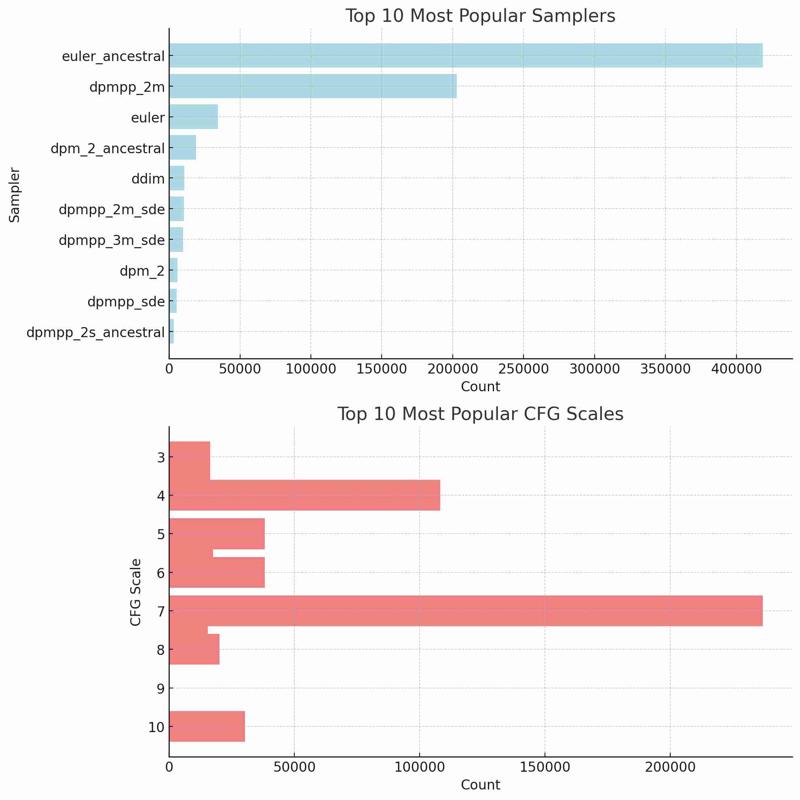
Sampler Analysis:
- Euler Ancestral dominates with 58.04% of the total usage, making it by far the most popular sampler in this dataset.
- DPM++ 2M follows with 28.15%, approximately half of Euler Ancestral's usage. The gap between these two and the rest is substantial.
- The remaining samplers, such as Euler (4.76%) and DPM++ 2M SDE (1.47%), fall into outlier territory with significantly lower usage, indicating their niche popularity compared to the dominant samplers.
### CFG Scale Analysis:
- 7.0 leads the pack with 44.04% of total usage, demonstrating its popularity in generation settings.
- 4.0 comes in second, with 20.12%, roughly half the usage of 7.0.
- Other values, like 10.0 (5.65%) and 5.0 (7.09%), show a notable but much smaller level of adoption.
These percentages illustrate the clear preferences in both samplers and CFG scale values, with a few dominant choices standing out and the rest occupying niche roles in the generation process.
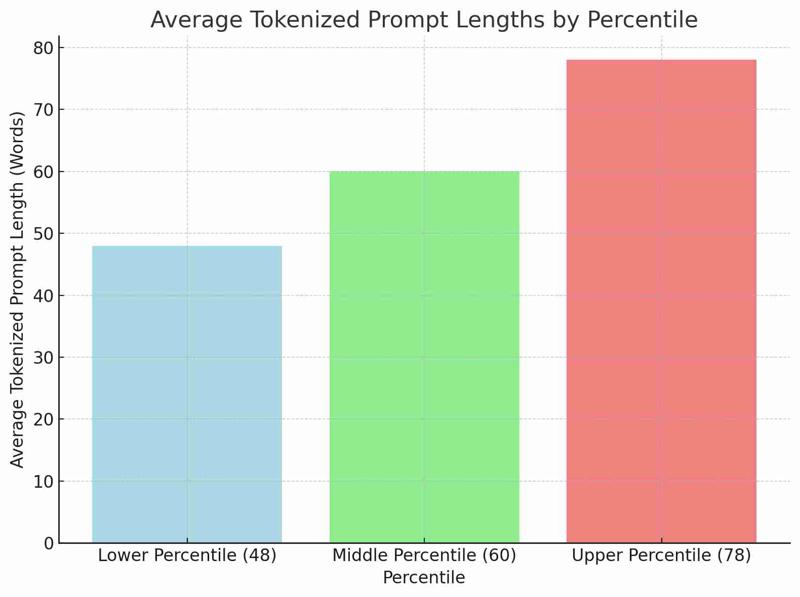
Average Prompt Lengths:
The data you're seeing here represents an analysis of how many words are used in prompts across the CivitAI dataset. We categorized prompts into three groups: those with shorter word counts (lower percentile), medium word counts (middle percentile), and longer word counts (upper percentile).
To get this data, we queried the prompts and counted how many words were used in each one. A "word" was defined by a certain pattern where only words that are three or more characters long are considered. For example, words like "cat" or "house" would be counted, but shorter fragments or symbols wouldn't be included. Even if an underscore ( _ ) is used between words, the tokenizer still sees it as one word rather than splitting it into two.
Based on the results:
- The lower percentile prompts used an average of 48 words, meaning these are typically shorter or more concise prompts.
- The middle percentile prompts were slightly longer, using around 60 words.
- The upper percentile prompts were the longest, with an average of 78 words.
This means that as prompts get longer, there’s about a 50% increase in the number of words used compared to the shorter prompts. The chart above shows how prompt lengths grow from shorter to longer, and how the community's prompts vary in length depending on what users are aiming to generate.
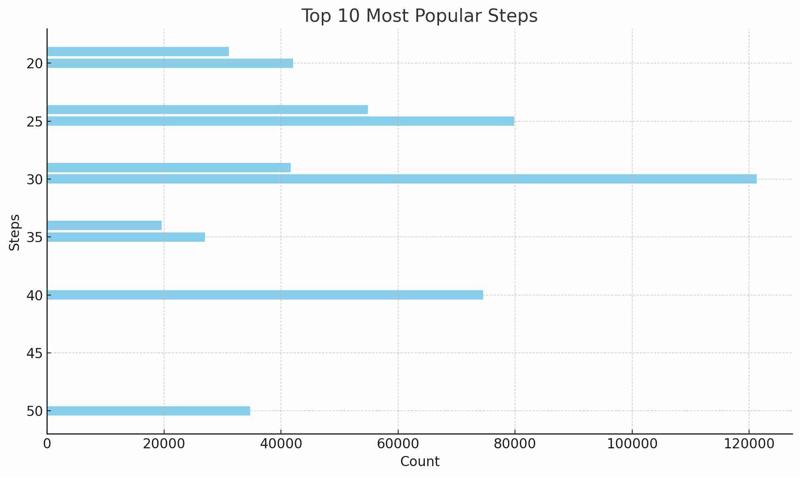
Step Count Analysis:
Based on the data, the following insights can be drawn:
- 30 steps is by far the most popular setting, accounting for 23.04% of the total usage. This suggests that many users find 30 steps to be the "sweet spot" for generating images.
- 25 steps follows in second place with 15.16%, while 40 steps comes in third at 14.15%. Both of these values are also commonly selected, likely influenced by users choosing increments of 5 from CivitAI's step slider.
- Among odd-numbered steps, 24 steps stands out as the highest, making up 10.41% of the total. This is followed by 29 steps at 7.90%, showing that even though most users stick to multiples of 5, there's still a significant portion of users opting for slightly non-standard values.
This data reflects that most users lean toward settings in multiples of 5, likely due to the user interface encouraging these choices. However, the presence of popular odd-numbered settings like 24 and 29 indicates that a portion of the user base experiments with fine-tuning beyond standard presets.
Loras & Embeddings
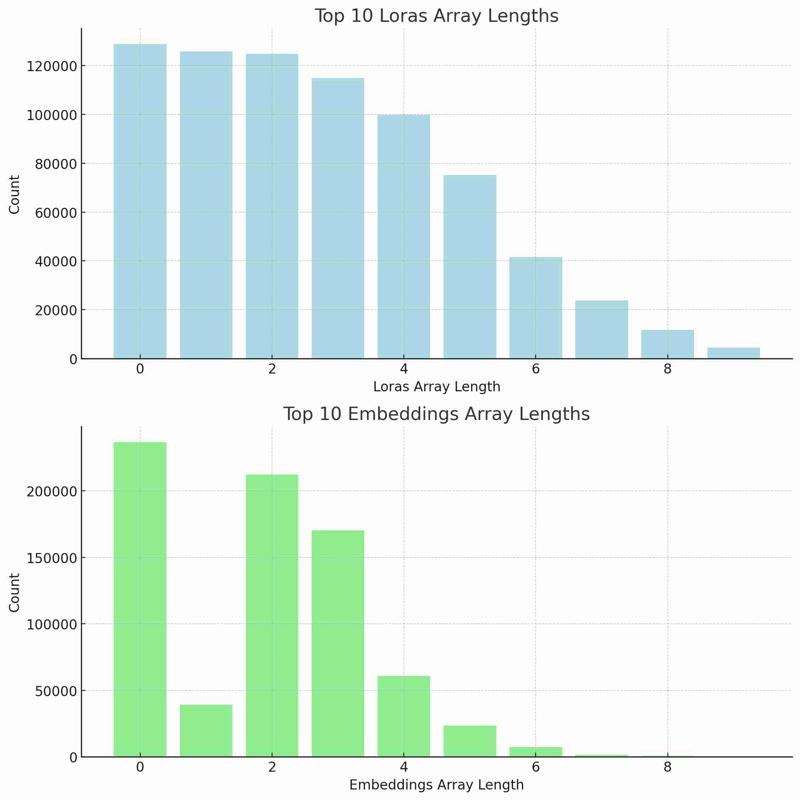
In terms of Loras usage, we observe that array lengths of 1 to 3 dominate the dataset. Most users prefer working with a small number of Loras models in their image generations. There is a clear drop-off in usage when the array length reaches 3 Loras or more, indicating that very few users are experimenting with larger numbers of Loras. For example, only 220 images out of the 710K records utilized 9 Loras, highlighting how rare it is for users to employ such a high number of Loras models in a single generation.
When we shift focus to Embeddings, the data presents an interesting pattern: the majority of images (about 236K) do not use any embeddings at all. This is followed by a strange drop-off at an array length of 1, suggesting that users who opt for embeddings are more likely to include 2 embeddings rather than just one. It seems that when embeddings are used, it's common for users to pair them for more control over the generation. Another key insight is that more than 4 embeddings is exceptionally rare, with only about 60K images out of the 710K—roughly 8% of the total records—including 5 or more embeddings.
Overall, this analysis shows a clear trend toward minimal usage of both Loras and Embeddings, with small numbers being preferred. However, the small subset of users experimenting with larger numbers of Loras and Embeddings reflects the more advanced, experimental side of the community.
Analysis of Top Models:
Embeddings:
- Top 3 Models:
- safe_neg.pt and safe_pos.pt dominate the list with 452,303 uses each. This suggests that users frequently use both positive and negative embeddings together in their image generation workflow.
- In third place, easynegative.safetensors follows at 123,706 uses, which is significantly lower than the top two but still commands a strong presence.
- Compared to the Rest: The remaining models in the top 10, such as civit_nsfw.pt (**117,393**) and negative_hand-neg.pt (**32,479**), show a much lower count, indicating that while a handful of models are universally popular, others cater to more niche needs.
Loras:
- Top 3 Models:
- Expressive_H-000001.safetensors leads with 243,645 uses, indicating that this model is highly favored by users.
- add-detail-xl.safetensors is second, with 133,250 uses, showing that users often aim for more detailed outputs.
- incase_style_v3-1_ponyxl_ilff.safetensors follows closely in third with 103,350 uses, reflecting the community’s strong preference for stylized pony-based generations.
- Compared to the Rest: Models like g0th1cPXL.safetensors (**98,297**) and princess_xl_v2.safetensors (**94,571**) have notable, but much smaller usage counts compared to the top 3, suggesting that while they are popular, they don't reach the same level of adoption.
---
Filename Analysis of Embeddings:
- Positive vs. Negative Embeddings: The top two embeddings, safe_neg.pt and safe_pos.pt, clearly reflect a trend where users include both positive and negative embeddings in their image generations. Interestingly, we see that negative embeddings like easynegative.safetensors and negative_hand-neg.pt are also highly used.
- Grouping embeddings into two categories:
- Positive Embeddings: safe_pos.pt
- Negative Embeddings: safe_neg.pt, easynegative.safetensors, negative_hand-neg.pt, ng_deepnegative_v1_75t.pt, FastNegativeV2.pt, fcNeg-neg.pt
- Positive embeddings account for about 50% of the total usage, while negative embeddings combined account for the other 50%, showing a balanced use between both types in the CivitAI community.
---
Loras Filename Analysis:
- "Princess" Theme: The "princess" theme appears twice in the top 10, with princess_xl_v2.safetensors and princess_xl_v1.safetensors accounting for 94,571 and 22,992 uses respectively. This suggests that users favor the "princess" theme in their stylized creations.
- Themes and Styles: The filenames of other Loras models, such as Smooth Anime Style LoRA XL and g0th1cPXL, reveal that users are experimenting with both specific art styles (e.g., anime and gothic) and niche subjects like pony-themed generation (*incase_style_v3-1_ponyxl_ilff*).
These patterns offer insights into how users customize their generations, with a strong tendency towards both stylized themes and detailed customization through Loras and Embeddings.
Most Popular Parameters:
- Checkpoint: ponyDiffusionV6XL_v6StartWithThisOne
- Steps: 30
- Sampler: Euler Ancestral
- CFG Scale: 7.0
- Prompt Length (Lower Percentile): 48 words
- Prompt Length (Upper Percentile): 78 words
- Loras Used: Expressive_H-000001, add-detail-xl
- Embeddings Used: safe_neg, safe_pos
Conclusion:
After reviewing 750K records from CivitAI, clear patterns emerged regarding the community's preferences for generating images. Across parameters such as steps, samplers, CFG scales, and checkpoint selections, specific trends dominate. For example, 30 steps and the Euler Ancestral sampler are by far the most popular settings, likely influenced by the user interface and preferences for quicker yet effective generations. When it comes to prompt lengths, users tend to generate shorter prompts in the lower percentile (48 words) and longer, more complex prompts in the upper percentile (78 words), revealing an increase in prompt complexity with more detailed outputs. Additionally, the analysis shows a strong division between those who prefer realistic models (44%) and those who lean toward more stylized, artistic models (56%). Overall, these findings offer valuable insight into how the CivitAI community approaches image generation, highlighting both dominant settings and areas for further exploration.





